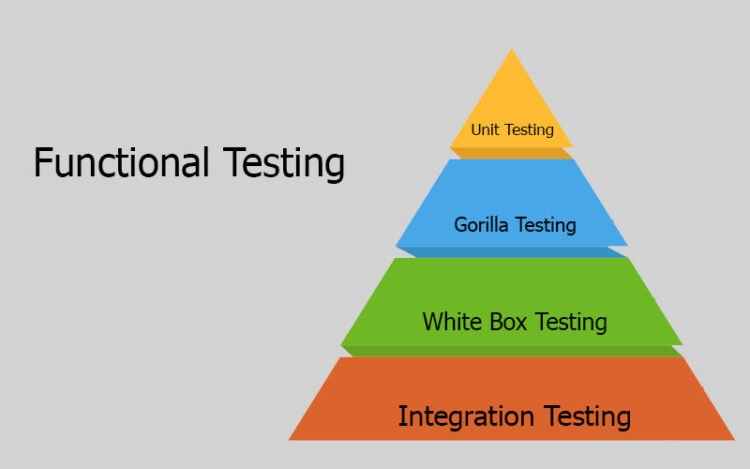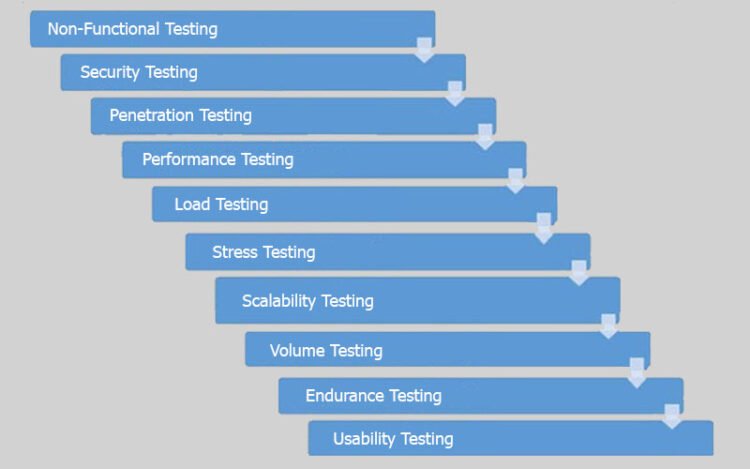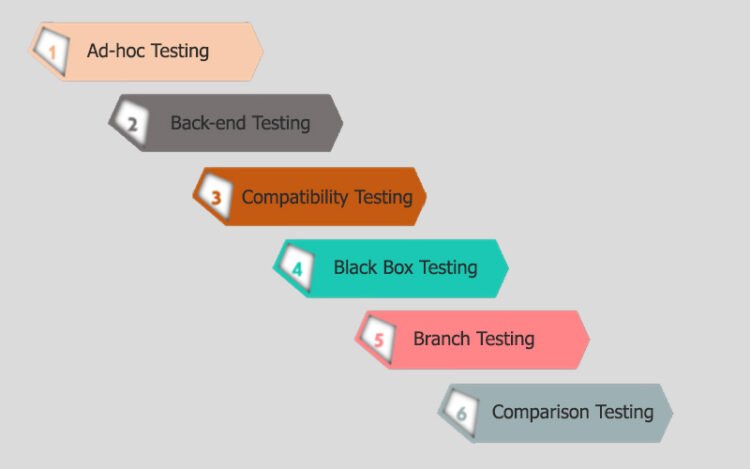Last updated on October 18th, 2022 at 05:40 am
All testers are aware of the various software testing types. These types include agile testing, automation testing, and non-functional and functional testing.
This is because they all come across different sorts of testing throughout their testing excursion. Some they have only heard about and some they have just worked on. However, everyone does not have knowledge regarding all testing types. All of the testing types have their own benefits, drawbacks, and features.
Keeping this scenario in mind, we will talk about all software testing types and how they are used in our everyday testing life.
Functional Testing
Functional testing has four main types.

1. Unit Testing
Unit testing could be a kind of software system testing that is conducted on a personal unit or element to check its corrections. Typically, Unit testing is finished by the developer in the applying development section. Every unit in unit testing may be viewed as a technique, function, procedure, or object. Developers usually use check automation tools like JUnit, Xunit, and NUnit for the assessment execution.
Unit checking is very important as a result we are able to realize additional defects at the unit test level. Unit testing is further divided into two types.
2. White Box Testing
White box assessment may be a test technique within which the inner structure or code of an app is visible and accessible to the tester. During this technique, it is simple to seek out loopholes within the style of an application or fault in business logic. Statement coverage and call coverage/branch coverage area unit samples of white box check techniques.
3. Gorilla Testing
Gorilla assessment could be a check technique during which the tester and/or developer test the module by applying completely all told aspects. Gorilla testing is conducted to visualize the degree to which your app is strong.
4. Integration Testing
Integration testing may be a sort of software system testing wherever 2 or additional modules of associated apps are logically sorted along and tested as a full. The main focus of this kind of testing is to search out the defect in the interface, communication, and information flow among modules. The top-down or bottom-up approach is employed whereas integration modules into the total system.
Gray Box Testing
As the name suggests, it is a combination of white-box testing and black-box testing. Testers have partial information on the inner structure or code of an application.
System Testing
In this testing type, a tester evaluates the complete system against the particular requirements.
a) End to End Testing
It incorporates a whole app environment in a situation that copies actual world use, such as systems, apps, or interaction with hardware and utilizing communication networks and databases.
b) Black Box Testing
Black box testing is a popular software testing methodology through which testing is done without taking into consideration the code of the system being evaluated, internal infrastructure, or design. Testers must concentrate on the input and the output of the testing aims.
Smoke Testing
Smoke checking is performed to verify that the basic and demanding practicality of the system below the test is functioning fine at a really high level.
Whenever a replacement build is provided by the event team, then the computer code. The testing team validates the build and ensures that no major issue exists. The testing team can make sure that the build is stable, and a close level of testing is going to be administered more.
Sanity Testing
Sanity testing is performed on a system to verify that recently another practicality or bug fixes area unit operating fine. Sanity testing is completed on a stable build. It is a set of regression assessments.
Happy Path Testing
The objective of Happy Path Testing is to check an app with success on a positive flow. It doesn’t search for negative or error conditions. The main focus is merely on valid and positive inputs through which the application generates the expected output.
Monkey Testing
Monkey Testing is dispensed by a tester, presuming that if the monkey uses the app, then how random input and values are going to be entered by the Monkey with no information or understanding of the app.
Acceptance Testing
Acceptance assessment could be a kind of testing wherever client/business/customer test the software system with real-time business eventualities.
The shopper accepts the software system only all the options and functionalities work obviously. This is often the last section of testing when the software system goes into production. This is often conjointly known as User Acceptance Testing (UAT).
a) Alpha Testing
It is a type of acceptance testing where testing is conducted by the team in a company to look at as many defects as possible prior to releasing software to the clients.
b) Beta Testing
Beta Testing may be a form of software system testing that is done by the clients/customers. This testing was performed within the Real setting before launching it to the marketplace for the particular end-users.
Beta Testing is done to confirm that there aren’t any major failures within the software system or product, an associate degree satisfies the business necessities from an end-user perspective. Beta Testing is productive once the client accepts the software.
Operational Acceptance Testing (OAT)
Operational acceptance testing of the system is performed by operations or system administration workers within the production surroundings. The aim of operational acceptance testing is to form certain that the system directors will keep the system operating properly for the users in an actual setting.
The Main Focus of the Operational Acceptance Testing is on the Following Points:

Assessment and restoring of the backup
Connecting, disconnecting, and updating the software.
The recovery procedure is if there is any sort of natural calamity.
User management
Software maintenance
Non-Functional Testing
The four main types of non-functional testing are mentioned and explained below in detail.
Security Testing
It is a sort of testing performed by a special team. Any hacking technique will penetrate the system.
Security Testing is finished to visualize whether the computer code, application or website is secure from internal and/or external threats. This testing includes what quantity of computer code is secure from malicious programs, and viruses and the way secure & robust the authorization and authentication processes area unit.
It additionally checks the way software behaves for any hacker’s attack & malicious programs and the way software is maintained for information security once such a hacker attack.
Penetration Testing
Penetration Testing or Pen testing is the sort of security testing performed as a licensed cyber-attack on the system to seek out the weak points of the system in terms of security.
Pen testing is performed by outside contractors, typically referred to as moral hackers. That’s why it’s additionally referred to as moral hacking. Contractors perform totally different operations like SQL injection, uniform resource locator manipulation, Privilege Elevation, session termination, and supply reports to the organization.
Performance Testing
Performance testing is the testing of an associate degree application’s stability and latency by applying load.
The word stability means the flexibility of the applying to face up to within the presence of load. Response time is quickly connected to an application that is available to the users. Performance testing is completed with the assistance of tools. Loader.IO, JMeter, LoadRunner, etc. are sensible tools offered within the market.
Load Testing
Load testing is the testing of an application’s stability and latency by applying a load, that is capable of but within the designed range of users for an application.
Stress Testing
Stress testing is testing an app’s response time and stability by applying a load that is over the designed variety of users for an app.
Scalability Testing
Scalability testing is testing an app’s time interval and stability by applying a load that is over the designed variety of users for an app.
Volume Testing (flood testing)
Volume testing is testing an associate degree application’s stability and interval by transferring an oversized volume of information to the info. Basically, it assesses the capacity for data to manage the flow of information.
Endurance Testing (Soak Testing)
Endurance testing is testing an app’s latent period and stability by applying load endlessly for an extended period to verify that the application is functioning fine.
Usability Testing
Usability testing is testing an associate degree application from the user’s perspective to see the design and feel and user-friendliness.
The main plan of usability testing for this type of app is that before long because the user opens the app, the user ought to get a look at the market.
The three types of usability testing are mentioned and explained below in detail.
Exploratory testing
Exploratory Testing is informal testing conducted by the testing team. The target of this testing is to explore the appliance and appearance for defects that exist within the application. Testers use the information of the business domain to check the apps. Assessment charters are accustomed guide the alpha testing.
Cross-browser testing
Cross-browser testing is testing an application on completely different browsers, operational systems, and mobile devices to envision look and feel, and performance.
Why can we like cross-browser testing? The solution is when entirely different users use different operational systems, completely different browsers, and completely different mobile devices. The goal of the corporate is to urge decent user expertise no matter those devices.
Browser stack provides all the versions of all the browsers and every one mobile device to check the app. For learning functions, it’s sensible to require the free trial given by browser stack for a number of days.
Accessibility Testing
The aim of Accessibility Testing is to see whether or not the package or application is accessible for disabled individuals or not.
Here, in-capability means hearing loss, congenital disorder, mentally disabled, blind, old age, and different disabled teams. Varied checks area unit performed, like font size for visually disabled, color and distinction for the congenital disorder, etc.
Compatibility Testing
This is a testing sort within which it validates however software package behaves and runs during a completely different atmosphere, net servers, hardware, and network atmosphere.
Compatibility testing ensures that software packages will run on a completely different configuration, completely different databases, completely different browsers, and their versions. The testing team performs compatibility testing.
Other Types of Testing

Ad-hoc Testing
The name itself suggests that this testing is performed on an Impromptu basis, i.e., with no relevancy to the test suit and additionally with no setup or documentation in situ for this kind of testing.
The objective of this testing is to search out the defects and break the application by corporal punishment any flow of the application or any random practicality.
Impromptu testing is an off-the-cuff approach to finding defects and might be performed by anyone within the project.
Back-end Testing
Whenever an input or information is entered on the front-end application, it’s kept within the info and also the testing of such info is thought of as info Testing or Backend Testing.
There are completely different databases like SQL Server, MySQL, Oracle, etc. info Testing involves testing of table structure, schema, keep procedure, system, and so on. In Back-end Testing, the interface isn’t concerned, the tester’s area unit is directly connected to the info with correct access and testers will simply verify the information by running many queries on the info.
There may be problems known like information loss, deadlock, information corruption, etc throughout this back-end testing, and these problems are units vital to fixing before the system goes live into the assembly setting.
Browser Compatibility Testing
Browser Compatibility Testing is performed for net applications and ensures that the software system will run with a mix of various browsers and operational systems. this sort of testing conjointly validates whether or not an online application runs on all versions of all browsers or not.
Backward Compatibility Testing
It is a kind of testing that validates whether or not the newly developed computer code or updated computer code works well with the older version of the atmosphere or not.
Backward Compatibility Testing checks whether or not the remake of the computer code works properly with the file format created by an older version of the software. It conjointly works well with knowledge tables, data files, and knowledge structures created by the older version of that computer code. If any of the computer code is updated, then it ought to work well on high of the previous version of that software system.
Black Box Testing
Internal system style isn’t thought-about during this kind of testing. Tests area unit supported the wants and practicality.
Boundary Value Testing
This type of testing checks the behavior of the appliance at the boundary level.
Boundary worth Testing is performed to ascertain if defects exist at boundary values. Boundary worth Testing is employed for testing a unique number range. There is a lower and upper boundary for every vary and testing is performed on these boundary values.
If testing needs a range of numbers from one to five hundred, then Boundary worth Testing is performed on values at zero, 1, 2, 499, 500, and 501.
Branch Testing
This is popularly called Branch coverage or call coverage testing. It’s a sort of white box-checking performed at the unit test level. It is done to create certain that every potential path from the choice purpose is dead a minimum of once for 100 percent of check coverage.
Comparison Testing
Comparison of the weaknesses and the strength of the product with its old version or other same products are called comparison testing.
Equivalence Partitioning
It is a testing technique and a sort of recorder Testing. Throughout this Equivalence Partitioning, a collection of teams are designated and a couple of values or numbers square measure picked up for testing. It’s understood that everyone’s values from that cluster generate constant output.
The aim of this checking is to get rid of redundant test cases at intervals in a particular cluster that generate a constant output but not any defect.
Example Testing
Example testing is time period testing. It includes time period situations and situations area unit supported the expertise of the testers.
This type of testing is additionally called experience-based testing, as a result, it uses the tester’s information about how the appliance has worked in the past, the way to break the appliance, and what quite errors area unit common during this style of application.
Graphical User Interface (GUI) Testing
The objective of this GUI Testing is to validate the GUI as per the business demand. The expected GUI of the appliance is mentioned within the elaborated style Document and GUI mockup screens.
GUI Testing includes the dimensions of the buttons and input fields’ gift on the screen, alignment of all text, tables, and content within the tables.
It conjointly validates the menu of the appliance. When choosing the completely different menu and menu things, it validates that the page doesn’t fluctuate, and therefore the alignment remains identical when hovering the mouse on the menu or sub-menu.
Incremental Integration Testing
Incremental Integration Testing may be a bottom-up approach for testing, i.e. continuous testing of associate degree applications once new practicality is additional.
Application practicality and modules ought to be freelance enough to check one by one. This is often done by programmers or by testers.
Install/Uninstall Testing
Installation testing is performed to ascertain that the code application is put in properly and dealing as per expectation. Installation testing may be a part of testing before users move with the particular application for the primary time. Installation testing is additionally known as “Implementation Testing”.
Uninstallation Testing is performed to substantiate if all the parts or components of the code area unit are aloof from the system or not.
Installation and Uninstallation Testing is completed on full, partial, or upgraded install/uninstall processes on totally different software and hardware environments.
Mutation Testing
Mutation Testing may be a kind of white box-checking during which the source code of one program is modified and verifies whether or not the prevailing test cases will determine these defects within the system.
The amendment within the program source code is extremely lowest, thus it doesn’t impact the complete application, solely the precise space having the impact also the connected check cases ought to be ready to determine those errors within the system.
Negative Testing
The outlook of the tester is to “Break the app/system” and it’s achieved through Negative Testing.
The negative Testing technique is performed exploitation of incorrect knowledge, invalid knowledge, or input. It validates if the system throws a slip-up of invalid input and behaves of course.
It mustn’t take a lot of time to load any page or system and will be sustained throughout peak load. Totally different performance tools are incorporated to try this testing.
Recovery Testing
It is a sort of testing that validates however well the appliance or system recovers from crashes or disasters.
Recovery Testing determines if the system will continue its operation when a disaster. Assume that the appliance is receiving knowledge through a network cable and suddenly that network cable has been unplugged.
Sometime later, insert the network cable; then the system ought to begin receiving knowledge from wherever it losses the connection because of the network cable being unplugged.
Regression Testing
Regression testing is testing of unchanged options of the application to create positive that any bug fixes, adding new options, deleting, or changing existing options, don’t seem to be impacting the operating application.
Finding out regression scope is a crucial half of Regression Testing. To seek out regression scope, the Tester must verify the world of application wherever changes happened and therefore the impact of these changes on the whole application. it’s troublesome to hide the full regression check suite in each unleash, thus Automation Testing Tools square measure employed in regression testing.
Risk-Based Testing (RBT)
For Risk-Based Testing, the functionalities or needs are assessed based on the priority. Risk-Based Testing includes testing of extremely essential practicality, that has the best impact on business and during which the likelihood of failure is incredibly high.
Priority selections are supported by business wants, thus once priority is ready for all functionalities, then high priority practicality or taking a look at cases are dead initial, followed by medium so low priority functionalities.
Low priority practicality could also be tested or not tested supported the obtainable time. Risk-Based Testing is administered if there’s meagerly time obtainable to check the complete package and therefore the package has to be enforced on time with no delay.
This approach is followed solely by the discussion and approval of the consumer and senior management of the organization.
Static Testing
Static Testing may be a form of testing that is completed while not the execution of any code. Reviews, walkthroughs, and inspections are completely different ways of acting on static testing. Activities like reviewing demand documents, client demand specifications, high level, and low-level style, code syntax, naming standards, etc. come under the family of static testing.
Static Testing additionally applies to check cases, test plans, and test situations. Static testing is completed to forestall the defect instead of catching the defect at a later stage. That’s why static testing is cost-efficient.
Vulnerability Testing
This type of testing involves characteristic weaknesses within the package, hardware, and network and is understood as Vulnerability Testing. In malicious programs, the hacker will take charge of the system, if it’s liable to such forms of attacks, viruses, and worms.
We need to envision if those systems endure Vulnerability Testing before production. it should establish vital defects and flaws in security.
Conclusion
There are more than a hundred testing types that have not been mentioned in the list. Everyone does not have any sort of expertise in applying these testing. Therefore, they take the help of software testing tools and software testing companies

Latest Businesses helps you list your business on every possible business directory in the best possible way to increase your business is seen and recognized. This will increase the reach of your business profile in searches across different search engines.
